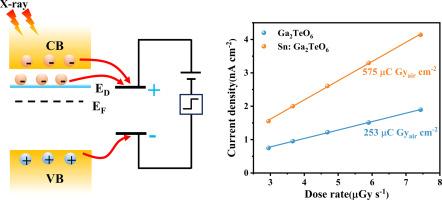提高Sn: Ga2TeO6晶体x射线探测灵敏度的载流子迁移寿命和电阻率平衡
IF 13.2
1区 工程技术
Q1 ENGINEERING, CHEMICAL
引用次数: 0
摘要
高性能的直接x射线探测器在医学放射照相、安全检查等各个领域都是至关重要的。然而,由于超高电阻率,大多数用于x射线探测的氧化物晶体仍然具有挑战性。本文认为在半导体中离子掺杂是平衡x射线探测灵敏度和探测极限的有效策略。本文采用顶种溶液生长(TSSG)技术,对Ga2TeO6和Sn: Ga2TeO6晶体进行了合理设计和成功生长。沿着一个c-axes,电阻率和载流子迁移率一生(μτ)Ga2TeO6水晶产品确定为2.93 ×1013 Ω 5.44厘米, × 10−4 cm2 V−1和2.65 ×1013 Ω 6.93厘米, × 10−4 cm2 V−1,分别。基于Ga2TeO6晶体的x射线探测器检测灵敏度分别为220 μC Gyair−1 cm−2和253 μC Gyair−1 cm−2,低检出限分别为12.1和48.9 nGyair s−1。由于高效掺杂,Sn: Ga2TeO6沿c轴的电阻率和μτ积分别优化为9.51 × 1012 Ω cm和1.76 × 10−3 cm2 V−1。因此,Sn: Ga2TeO6的灵敏度提高到575 μC Gyair−1 cm−2,是Ga2TeO6晶体的2倍,检测限为97.0 nGyair s−1。这项工作提供了一种新的x射线探测材料,并提出了一种有效的策略来提高材料,特别是高电阻率晶体的x射线探测灵敏度。本文章由计算机程序翻译,如有差异,请以英文原文为准。

Balance of charge carrier mobility-lifetime and resistivity for enhancing X-ray detection sensitivity in Sn: Ga2TeO6 crystal
High-performance direct X-ray detectors are critical in various fields such as medical radiography, security checks, and so on. However, due to ultrahigh resistivity, most of the oxide crystals used in X-ray detection are still challenging. In this paper, ion doping in semiconductors is considered to be an effective strategy to balance the X-ray detection sensitivity and detection limit. Here, both Ga2TeO6 and Sn: Ga2TeO6 crystals are rationally designed and successfully grown by the top-seeded solution growth (TSSG) technique. Along the a- and c-axes, the resistivities and carrier mobility lifetimes (μτ) products of Ga2TeO6 crystal are determined to be 2.93 × 1013 Ω cm and 5.44 × 10−4 cm2 V−1, and 2.65 × 1013 Ω cm and 6.93 × 10−4 cm2 V−1, respectively. The Ga2TeO6 crystal-based X-ray detectors show the detection sensitivities of 220 μC Gyair−1 cm−2 and 253 μC Gyair−1 cm−2 and low detection limits of 12.1 nGyair s−1 and 48.9 nGyair s−1, respectively. Due to efficient doping, the resistivity and μτ product in Sn: Ga2TeO6 along the c-axis are optimized to 9.51 × 1012 Ω cm and 1.76 × 10−3 cm2 V−1. Thus, the sensitivity of Sn: Ga2TeO6 is enhanced to 575 μC Gyair−1 cm−2, which is two times that of Ga2TeO6 crystal, and the detection limit is determined to be 97.0 nGyair s−1. This work provides a new X-ray detection material and proposes an efficient strategy to enhance the X-ray detection sensitivity of materials, especially for high-resistivity crystals.
求助全文
通过发布文献求助,成功后即可免费获取论文全文。
去求助
来源期刊

Chemical Engineering Journal
工程技术-工程:化工
CiteScore
21.70
自引率
9.30%
发文量
6781
审稿时长
2.4 months
期刊介绍:
The Chemical Engineering Journal is an international research journal that invites contributions of original and novel fundamental research. It aims to provide an international platform for presenting original fundamental research, interpretative reviews, and discussions on new developments in chemical engineering. The journal welcomes papers that describe novel theory and its practical application, as well as those that demonstrate the transfer of techniques from other disciplines. It also welcomes reports on carefully conducted experimental work that is soundly interpreted. The main focus of the journal is on original and rigorous research results that have broad significance. The Catalysis section within the Chemical Engineering Journal focuses specifically on Experimental and Theoretical studies in the fields of heterogeneous catalysis, molecular catalysis, and biocatalysis. These studies have industrial impact on various sectors such as chemicals, energy, materials, foods, healthcare, and environmental protection.
 求助内容:
求助内容: 应助结果提醒方式:
应助结果提醒方式:


